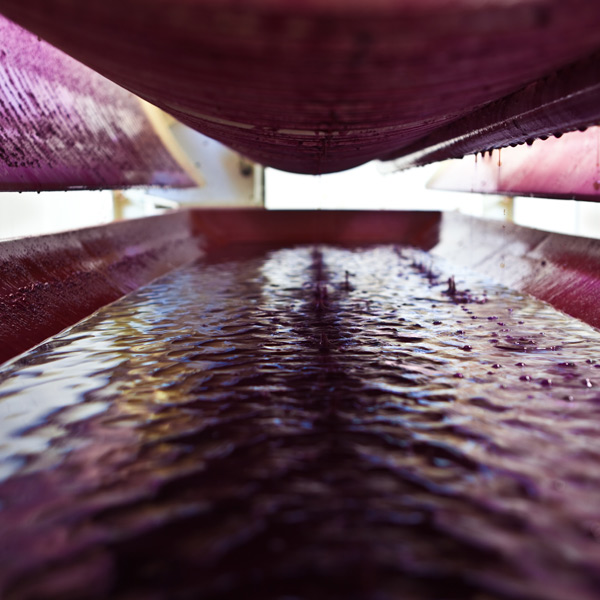Press Operation & Press Fractions
Blog Post

Unless you’re a winemaker, study winemaking, or are an extremely knowledgeable wine consumer, the term “press fractions” probably reminds you of grade school mathematics class. However, the process of dealing with the pressed juice during the winemaking process is an extremely important component to what ends up making it into the bottle. Our winemaker Eric Baugher recently detailed our process here at Ridge for handling press juice, and with harvest right around the corner, we thought it was a perfect time to share.
A pneumatic (also called membrane) press is one of several winemaking tools we use during harvest. It differs from a hydraulic press or a continuous screw press in that it operates under low air pressure to inflate a membrane which gently presses liquid from red grape skins after fermentation, or from whole white grape clusters before fermentation. Our two presses are in constant use throughout the months of September and October—mostly pressing fermented red grape varieties, and occasionally pressing fresh chardonnay clusters. Press wine from larger-berry varieties like zinfandel can equal 30% of the final gallons-per-ton yield—for small-berry varieties, around 20%. Given high-quality grapes, the addition of press wine can significantly increase quality and complexity, adding depth of color, tannin, and spice.

Zinfandel’s press is particularly comparable in taste to its free run, mostly because it’s not a tannic grape. For more-tannic grapes, such as Monte Bello’s Bordeaux varieties, or petite sirah and syrah from Lytton Estate, collecting fractions at different pressure points throughout the press cycle becomes essential. We have, in certain tannic vintages, separated as many as seven different fractions from Monte Bello fermentors. We call the first fraction “tank drain”; it is the remaining free-run that has slowly drained from the skins overnight. No pressure is applied; it’s just a collection of the loosely-bound wine trapped in the cap of skins. Best characterized as saturated free-run, it is deeply colored, rich in tannins, and very fruity. We usually return it to the free-run of that same lot. Once skins from the tank have been loaded into the membrane of the press, it sits for thirty minutes, draining a second fraction called “press free-run” (PFR). This fraction can taste fairly astringent, and shows more exposed tannins. It’s usually held out. The press is then started, and for the first half-hour the membrane is lightly inflated to 0.25 atmosphere of pressure. This is when the largest quantity of press wine is extracted, and is called “first squeeze.” This third—and almost always toughest—fraction lacks body, shows coarse tannins, and is typically a mix of strong herbaceous and yeasty flavors. We always hold this fraction out of the free-run lots, sending it to its own group of barrels. Once the first squeeze has been collected, the membrane will inflate to higher pressure points in one-tenth atmosphere increments. Press 1-1 and Press 1-2 are collected between 0.3 and 1.0 atmosphere. Both can be quite amazing—tasting like free-run, but amplified in intensity, especially Press 1-2. In most vintages, we collect both as a single fraction and call it “first press.” It doesn’t amount to much wine, but is often added back to the free-run, where it can amplify body, providing further richness and high-quality tannins. The final two press fractions are collected at the end of the cycle, with pressures from 1.0 to 2.0 atmospheres. This is still fairly gentle, not forceful enough to break seeds, but allowing the final quantity of press wine to be extracted. This portion can take on a strong aroma and flavor of the grape skins—what we call a “pomace” character. As with first press, in most vintages P2-1 and P2-2 are combined as a single fraction known as “second press.” This fraction, too, can be amazing—if it’s not too tannic. Often, we add the best lots to free-run, and occasionally even include it in Monte Bello assemblage tastings.
Once the press operation has finished, and all fractions from each fermentor collected in tanks with separate compartments, we taste, grading quality as “A” or “B” and, if it’s really tough press wine, sometimes “C”. Any fractions that can be combined are transferred to separate barrels, where they will undergo natural malolactic fermentation. Once finished, the press lots are tasted again, and the different press categories consolidated by quality. At this early stage, we set up fresh egg-white fining trials to determine how many whites per barrel are needed to moderate the texture of the tannins. In the most tannic vintages, it might require three or four separate finings to achieve softening, and perhaps two years or more in barrel. On the few occasions that a press wine doesn’t soften, we will not blend it into any Ridge wine. At that point, the only option is to sell it on the bulk-wine market, though that is rare for us. With enough fresh egg whites, and the patience to wait for barrel age to soften the wines, we can usually turn around even the toughest press fractions.
We first separated press fractions in 1997. The best, added to the Monte Bello, increased its quality significantly. Each year we gain experience, further perfecting our approach.
Eric Baugher (5/14)
Wait!
In order to qualify for user related discounts, you must log in before proceeding with checkout. Click the button below to log in and receive these benefits, or close the window to continue.
Log In